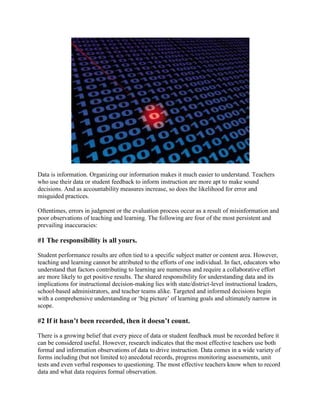
Data Myths
- 1. Data is information. Organizing our information makes it much easier to understand. Teachers who use their data or student feedback to inform instruction are more apt to make sound decisions. And as accountability measures increase, so does the likelihood for error and misguided practices. Oftentimes, errors in judgment or the evaluation process occur as a result of misinformation and poor observations of teaching and learning. The following are four of the most persistent and prevailing inaccuracies: #1 The responsibility is all yours. Student performance results are often tied to a specific subject matter or content area. However, teaching and learning cannot be attributed to the efforts of one individual. In fact, educators who understand that factors contributing to learning are numerous and require a collaborative effort are more likely to get positive results. The shared responsibility for understanding data and its implications for instructional decision-making lies with state/district-level instructional leaders, school-based administrators, and teacher teams alike. Targeted and informed decisions begin with a comprehensive understanding or ‘big picture’ of learning goals and ultimately narrow in scope. #2 If it hasn’t been recorded, then it doesn’t count. There is a growing belief that every piece of data or student feedback must be recorded before it can be considered useful. However, research indicates that the most effective teachers use both formal and information observations of data to drive instruction. Data comes in a wide variety of forms including (but not limited to) anecdotal records, progress monitoring assessments, unit tests and even verbal responses to questioning. The most effective teachers know when to record data and what data requires formal observation.
- 2. #3 We must use everything. Educators who are selective in their determination of which data access points to consider are better informed. We are constantly bombarded with information and not all of it is useful. Moreover, students sometimes respond or behave in a manner inconsistent with their actual levels of performance. Effective teaching practice includes a heightened sense of awareness matching ability with expected levels of performance. Such keen awareness is likely to help educators better analyze information and use it to make sound instructional decisions. #4 "Let's agree-to-disagree." The most prevailing—and probably most damaging—misuse of data is the inaccurate analysis of information or student feedback. When professionals collaborate to analyze data they must have a common understanding of what the information reveals. Consider this- Three teachers meet at the onset of the school year in order to review their students’ performance on a state-level assessment. The assessment describes student performance in terms of levels (e.g., level 1, level 2, level 3) with a predetermined score for proficiency. Each teacher's analysis is centered on his or her response to one question: What does an achievement level 1 indicate? Multiple responses to this question may indicate a misinterpretation of the data. In turn, this is likely to prevent an accurate analysis. Professionals may disagree on the causes or factors that attribute to one score or another or even the most appropriate next steps. However, it is critical that all parties begin with a solid and unifying understanding of individual data points to prevent the likelihood of misguided instructional practices. Sources Coyne, M. (1997). Weaving authentic assessment into the tapestry of learning. CC-VI Forum, (1), 1-2. Herman, J., & Winters, L. (1992). Tracking your school's success: A guide to sensible evaluation. Los Angeles, CA: Los Angeles Center for Research on Evaluation, Standards, and Student Testing, University of California. Shepard, L.A. (1995). Using assessment to improve learning. Educational Leadership, 52(5), 38-43. Copyright Dessalines Floyd. Contact the author to obtain permission for republication.
